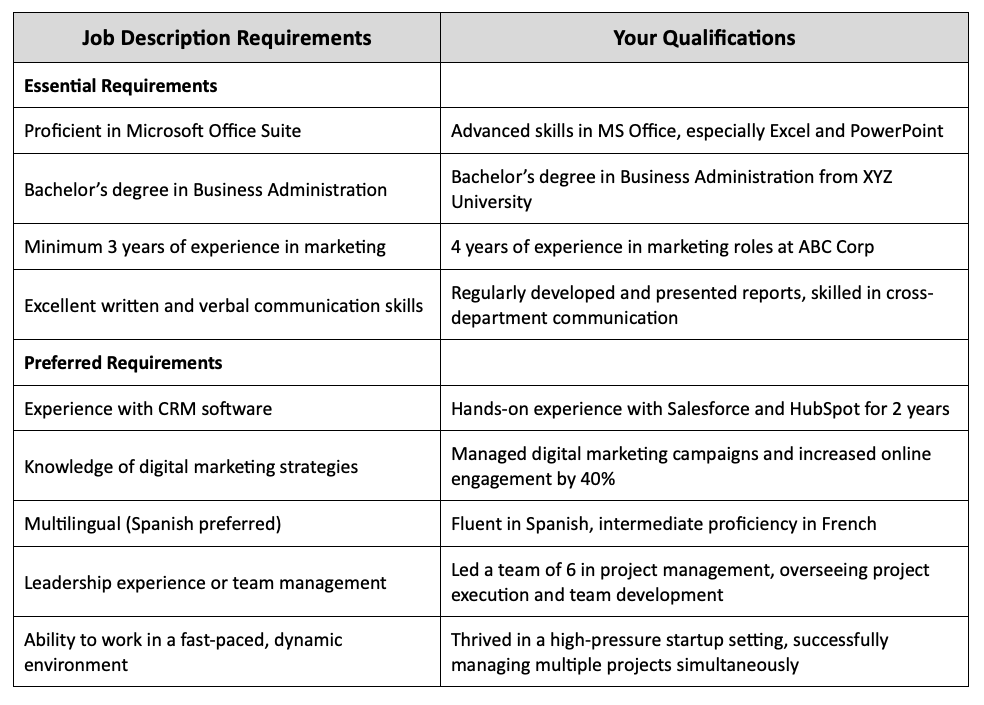In this article, we discuss the significance of conducting a job fit analysis and how it goes beyond simply matching keywords in your resume to the job description. We will introduce the T-chart method, an effective job analysis tool that helps align your skills and experiences with the specific requirements of a job. This method not only ensures that you apply for roles that best fit your skill set but also greatly enhances your chances of being selected.
Table of content
Why does a good job fit matter?
The alignment of personal skills and experience with job requirements is a critical factor in the job application process. This alignment not only ensures that candidates are applying for roles that are a good fit for their skill set but also significantly enhances their chances of being selected for the role.
According to a study by the National Association of Colleges and Employers, HR professionals prioritize candidates who can demonstrate they have the skills and experiences directly related to a particular role. Furthermore, a report by TalentWorks highlights that applicants who match 50-60 percent of their skills and experiences with job requirements are twice as likely to be shortlisted for an interview than applicants with a 40 to 50 percent match.
This highlights the importance of tailoring resumes to each specific job, emphasizing relevant skills and experiences that correspond to the job’s demands. Such a strategic approach to job applications not only streamlines the hiring process for employers but also guides candidates towards opportunities where they can thrive and contribute most effectively.
Understanding the person-job fit assessment
Thoroughly reading and understanding job descriptions is pivotal in conducting a comprehensive job fit. This process involves examining the job responsibilities, duties, and skills required, ensuring a perfect job fit. A thorough job suitability facilitates a practical job evaluation, identifying aspects of the job critical for performing the role successfully. It helps in determining both cultural and organizational fit, which is crucial for long-term performance and job satisfaction. Ultimately, a detailed job fit analysis is often the cornerstone of a successful job search.
When searching for a job, it’s important to assess whether the company’s culture and values align with your own. This involves analyzing the job post and description, understanding the key aspects of the position, and evaluating how these align with your skills and values. The concept of organizational fit is crucial in job analysis, as it determines whether you will be a good match for both the role and the company’s current work environment.
By analyzing the company’s organizational culture, you can assess the overall fit and ensure that the job aligns with your career aspirations and personality traits. In addition to the job requirements, it’s essential to understand the company’s values to prepare for the interview process. A good job fit benefits both you and the employer by increasing the likelihood that you will thrive in your role, have a great culture fit, and potentially advance to senior or managerial positions. From an employer’s perspective, a good job fit also decreases turnover and makes the hiring decision easier.
The job fit assessment method
Conducting a self-assessment is a crucial step in the job application process, especially when it comes to understanding how well your skills and experiences align with a specific job. This process, commonly referred to as a job fit assessment, can significantly enhance your chances of finding a perfect job that matches your competencies and career aspirations. A thorough job fit analysis is often the foundation of an effective job fit assessment.
Job analysis method: The T-chart
One practical and essential concept in job fit analysis is the T-chart method. This analysis method involves creating a two-column chart. On one side, you list the job specifications and competencies as stated in the job description. On the other side, you map your skills and experiences against these requirements. Let’s see an example of a job fit analysis using a T-chart, with both essential and preferred job requirements.

How to distinguish between a perfect job fit and a poor job fit?
The job fit assessment process is a critical tool for job seekers to evaluate how well they fit a role, mainly when using a T-chart to compare their qualifications against a job post’s requirements. This method involves analyzing the job tasks and requirements listed in the job posting and then systematically assessing one’s skills and experiences to see if they align.
Reading the job fit results
To determine if you meet 80% or more of the essential qualifications and some preferred qualifications, start by listing each requirement under ‘needed to perform the job’ and ‘preferred skills’ in the job description. Next, match your qualifications against these. This thorough job examination will help you understand the functions of the job and assess your suitability.
For each requirement, consider whether your experience and skills are a robust match. If you meet a requirement entirely, that’s a full match. If you partially meet it, that’s a half-match. Tally up your full and half matches and compare them to the total number of requirements. If your full and half matches constitute at least 80% of the basic requirements, plus some preferred ones, you’re likely a good fit.
This job match analysis output is more than just a checklist; it’s a strategic tool to guide your application. It determines if you have the relevant skills and competencies needed to perform the job. It informs you how you should tailor your resume and prepare for interview questions, ensuring you highlight how effectively you can perform the job. The job match analysis process provides everything you need to know about your fit for the role, making it a vital step for job seekers.
In conclusion, taking the time to conduct a thorough job fit analysis using the T-chart method is essential for enhancing your job application process. This strategic approach can significantly improve your chances of finding roles that are not only a perfect match for your skills but also conducive to your career growth.






Leave a Reply